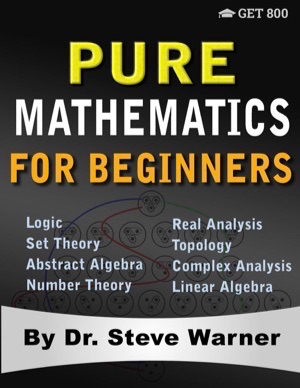Pure Mathematics for Beginners by Dr. Steve Warner, which is one of the books I mentioned in Resources for Math Learning (Intro to Math), is an exceptional breadth-first introduction to rigorous mathematics. It has a minimum of formal prerequisites and includes a lot of guidance for learning proof-writing, though if you haven’t seen at least some of the material before you may find it quite challenging. Indeed, I have seen some of the material before, and I still find much of it challenging. But it also has a wealth of easier material to ground the discussion, so the text is suitable for a wide range of learners.
Warner is an associate professor of mathematics at Hofstra University in New York, with research interests in set theory and computability. He is also the founder of a test-prep company called Get 800, which among other things is the publisher of Pure Mathematics for Beginners. The design of the cover (Figure 1) and the interior typesetting reflect these origins, which don’t always conform to the typical standards for academic math textbooks. I have not found this to be a significant distraction, though, and the content of the book is stellar. Warner is clearly a gifted educator, and the pedagogical aspects of the text are exceptionally well-designed.
As its name suggests, Warner’s book is aimed at “beginners” broadly defined, but it covers some quite advanced material. For example, the book’s treatment of abstract algebra includes subjects like normal subgroups and ring ideals, while the topology material includes topological bases and the separation axioms. These are topics that would typically be covered in abstract algebra or topology courses aimed at junior or senior math majors at a normal good university. In case Pure Mathematics for Beginners is too hard, Warner also has an easier version called Pure Mathematics for Pre-Beginners, which covers much of the same material but without the heavy emphasis on writing proofs.1
1 Eight chapters (and then eight more)
The approach Warner takes is deeply philosophically aligned with my own approach to learning mathematics (and to learning in general). Pure Mathematics for Beginners starts with eight chapters on eight different subjects, carefully layered to build on each other while still being as standalone as possible. The specific subjects appear as follows:
- Logic
- Set Theory
- Abstract Algebra
- Number Theory
- Real Analysis
- Topology
- Complex Analysis
- Linear Algebra
After those eight chapters, Warner includes eight more chapters, whose subjects follow a possibly recognizable pattern:
- Logic
- Set Theory
- Abstract Algebra
- Number Theory
- Real Analysis
- Topology
- Complex Analysis
- Linear Algebra
That’s right—Warner covers eight subjects in order, and then covers the same eight subjects in the same order, just adding an extra layer of depth. This is simply a marvelous approach—it’s the spiral approach I mentioned briefly in my post on strategies for math learning, and it’s a great way to gain a deep understanding while continuously progressing in difficulty.
2 Version considerations
I should mention at this point that I’m using the original, shorter version of Pure Mathematics for Beginners and not the Accelerated and Expanded Edition available at Amazon. (The original edition is also available at Amazon, though it points you to the Accelerated and Expanded Edition as a “newer edition of this item”.) As far as I can tell, the Accelerated and Expanded Edition uses the exact same format as the original version, consolidating most of the original sixteen chapters into the first eight and then adding eight more chapters on more advanced extensions of the eight core subjects.
I’m using the shorter version mainly because I want to move on more quickly to full-length books on individual topics (e.g., real analysis, linear algebra, and number theory), but it’s also because the shorter version’s main text and solutions manual are available on LibGen.2 I have no doubt, though, that a year or two spent intensively studying the Accelerated and Expanded Edition would be time well spent for students interested in pure mathematics. Depending on your goals, that could well be all the math background you’ll ever need.
3 Exercises
I’d also like to mention the exercises in Pure Mathematics for Beginners, which come in the convenient form of five levels in each chapter. The Level 1 problems are generally straightforward, with problems at higher levels getting progressively more difficult. And in case Level 5 isn’t enough for you, some chapters even include extra-hard “challenge problems”, such as proving the Cantor–Schröder–Bernstein theorem.3
As noted above, a full solutions manual to Pure Mathematics for Beginners is also available, which is a great boon to independent learners.4
4 Conclusion
Altogether, Pure Mathematics for Beginners is an outstanding and rigorous introduction to a broad range of topics in pure mathematics. Depending on your background, you might want to start with a book more focused on teaching how to write mathematical proofs (such as How to Prove It by Daniel Velleman), but for building a solid foundation it’s hard to go wrong with Warner (and in any case the two books have significant overlap and complement each other nicely). Anyone finishing this text should have ample background for further study in nearly all of the major fields of mathematics, including real and complex analysis, algebra, topology, and number theory.
